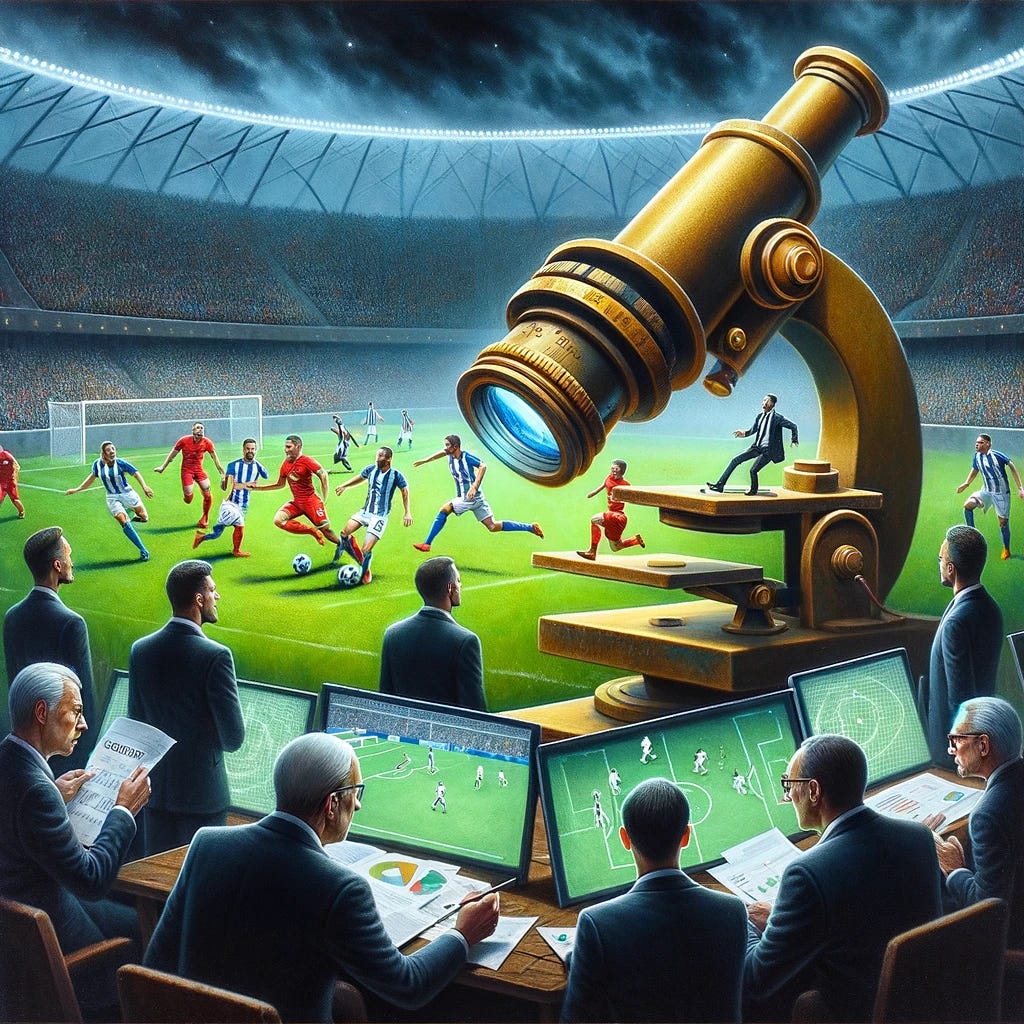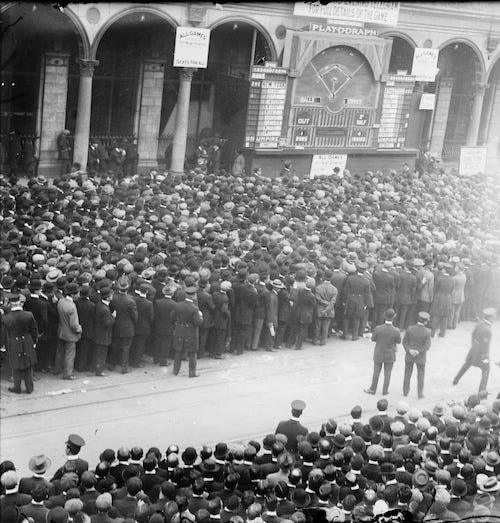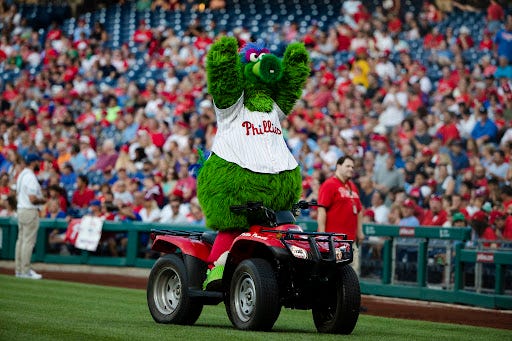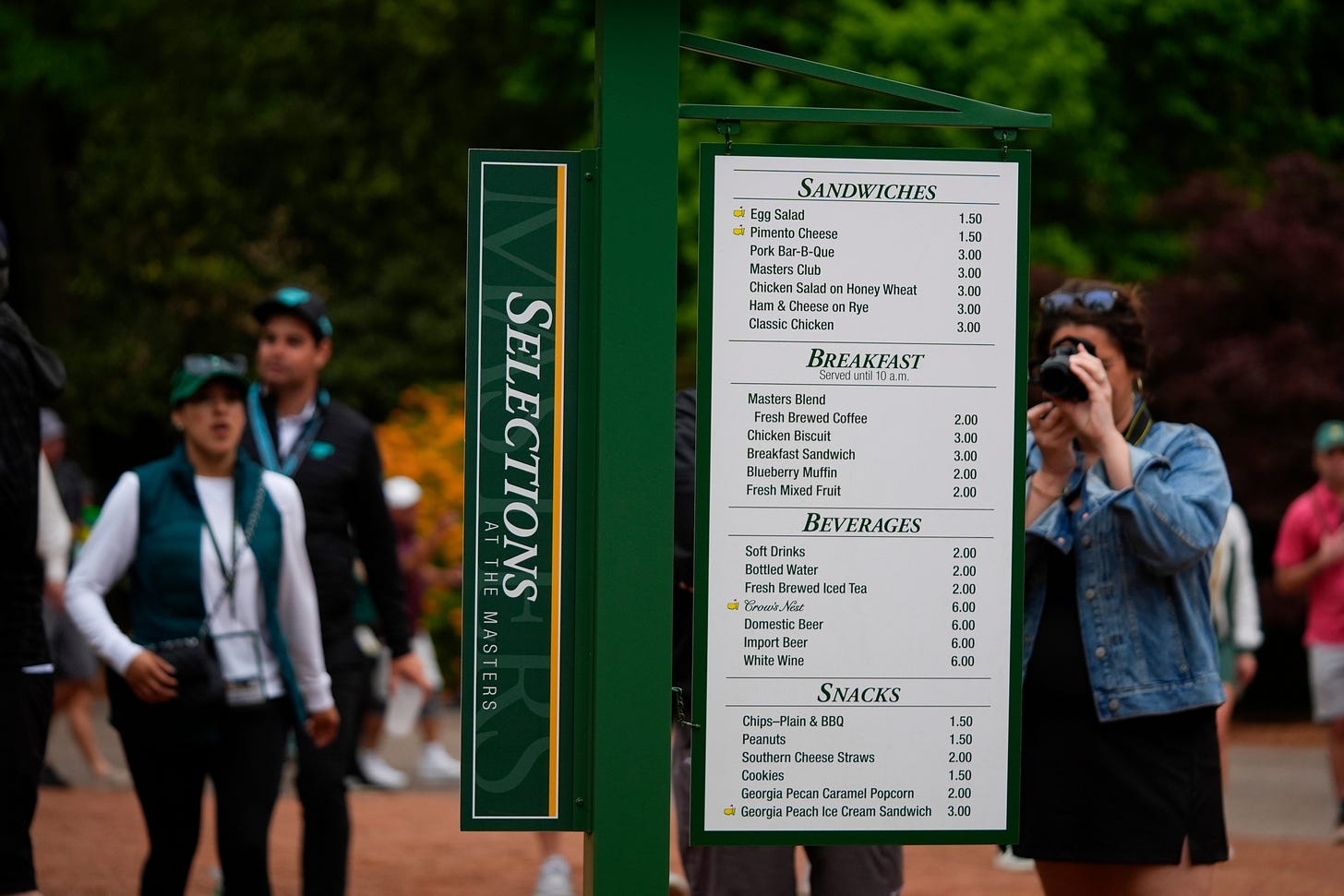McKinsey v. Masters
Or, Why Things Get Worse

Yes, this piece is going to talk about sports. Yes, it will be written in such a way that if you understand nothing about sports you can follow along with these two examples until I get to the main point I’m trying to illustrate. But I will not be offended if you just press the like button and skip this one if you’re that sportsphobic.
Over the past week, two interesting things happened in sports that provided - in their contrast - the perfect example of a divide in business that I was otherwise struggling to illustrate. But exploring them starts to explain one of the biggest puzzles in modern America, specifically with technology, that has cropped up over in recent years. Why do so many of the products and services we use seem to be getting worse?
Almost all of my plethora of sports loyalties are forged on one of three things. The first are the bonds of land. I was born in Philadelphia, I grew up outside the city, I am passionate about my Philadelphia teams. The second are bonds of blood. My family is Neapolitan, so I passionately support Neapolitan and Italian teams. The third are bonds of toil. I attended Temple University for law school, so I passionately support Temple athletics.
But then there’s just this weird one which is that I am a passionate supporter of Liverpool FC. So what happened? It’s entirely because of this:
I was won over by their fans. They seemed like a group to which I’d like to belong, and they made watching a blast. There’s a saying that football without fans is nothing. During the pandemic, we learned this to be true. Watching the sport – really, any sport – in empty arenas sucked.1 Being attracted to a sporting event or teams because of the fans is quite logical. But to understand why, let’s take a quick2 jaunt through history to see how sports, a $487 billion industry, is still run like there have been no technological advances of the past century.
Part of why sports are interesting is not just the size of the industry, but its newness. Yes, in many ways it’s ancient. But we don’t watch a lot of gladiatorial combat or chariot races. Our oldest currently popular team sports are baseball and football aka soccer aka calcio aka futbol aka a lot of other names but since most of my audience is American we’ll call it soccer. Sorry Brits. Although we don’t have exact records, we can trace both of them charging money to spectators to be an invention of the mid-19th Century. To put this in perspective that was shortly after the development of photography.
Back then, the various clubs would play each other, and people found this so compelling that they would come and watch. Ostensibly to defray the costs of maintaining the facilities, the clubs began charging these spectators a fee. This one action did two things. First, it turned sports into entertainment. Second, it launched a major industry. But in those early decades, there was only one way to be a customer: you would go down to the park and pay your money to watch.
This was the way being a sports fan existed for over half a century. But what happened was people really loved sports. I keep using fan as synonymous with customer – and will continue to do so – but really this was driven by two groups of people. The first were those who loved watching the game, many of whom became devotees of specific teams or clubs. This was often for very sound reasons, primarily geographical proximity. Root, root, root for the home team and all that. The second group were gamblers, whose insatiable need for betting helped drive much of the popularity and technological progress in early sports.
As these two loves grew, so did the demand to widen the footprint. In the 1870s, you could still only watch games in person. But you could at least know the results through newspapers. This fascinating article about the history of Syracuse’s live scoreboard – from which the picture below comes – shows that 19th Century Americans had the same voracious appetite to up to the minute sports scores as users of score apps today.
This was the state of sports until technology came along. In 1921, the first professional baseball game was broadcast over radio. Six years later the same would happen for soccer. In the 1930s, games were first shown on television. In the 1940s, well, there was a world war, people were busy. But in the 1950s television began to take over. And everything changed.
In Nicholas Nassim Taleb’s Black Swan, one of his most memorable discussions is about the effect that technology had local musicians. Once, you only needed to play music locally to make a living. How else would people listen to music? Then along came recorded music. Now, you needed to be better than the recording someone could buy. This dramatically changed music. And over the years music has adapted. People now realize they are paying for the experience of watching live music, not necessarily the quality of the music. Moreover, the benefits began accruing to those at the top. Whereas your local singer-songwriter may only be marginally worse than Taylor Swift, her bank account will be far inferior.
Sports was not immune from this. Every city, town, and hamlet large enough to support a team had a baseball team here or a soccer team overseas. Because your only way of watching these sports was supporting your local team. Television changed that. The benefits began accruing to the top. And although – whether through an open pyramid or a closed system – the top level had always rewarded larger cities, this was turbocharged. After initially charging only to defray costs, sports teams realized they could charge higher and higher prices. Eventually, they became big businesses. If you were based in a New York City or a London, with a far greater pool of potential customers, you could make more money and afford better players, a virtuous circle. And people like watching the best. But now, you could watch the best without being there in person.
This required a change, but it didn’t change everything. Back in the 1930s, there was a thriving minor league called the Pacific Coast League. Transportation technology did not allow for teams in New York and Boston to play teams in San Francisco and Los Angeles, so they had their own league. And it was filled with future legends such as Ted Williams and Joe DiMaggio. And they did well. For example, in 1937, Joe’s old team – the San Francisco Seals – average about 2,500 fans per game. In that same year, the St. Louis Browns averaged almost a thousand fewer fans per game. Yes, they were terrible. But St. Louis was a far larger city. The next worst team in the league – the Philadelphia Athletics – averaged 5,500 fans per game, despite Philadelphia being three times the size of San Francisco.
Today, the gaps are not as extreme as you would expect. Because minor league baseball teams realized they still had a niche: live sports. And they embraced it. Last season, the Lehigh Valley Iron Pigs averaged 7,990 fans per game, the best in minor league baseball. Those same Athletics – relocated to Oakland from Philadelphia (with a stop over in Kansas City) – only drew 10,276 fans per game.3 Baseball as a live attendance sport did not radically change. On average, major league teams draw seven times as many fans, which considering the massive difference in populations they draw off, is not astounding.
Now look at television ratings. Or, at least we would if we could. Most minor league baseball games aren’t televised except through online streaming. The closest I could find was that the Louisville Bats were the sixth most watched minor league baseball team with 24,000 total views. Meanwhile, millions of people watch Major League Baseball games every night. This is the reason why the most recent information I could find on minor league team value comes from 2016, and puts the Sacramento River Cats at a $49 million valuation, about $62 million in today’s money. Meanwhile, the big league teams range from a billion dollars for the Miami Marlins – who don’t even have fans – to over seven billion for the New York Yankees.
What did change was television. Minor league baseball games aren’t even televised. They remained a viable live sporting event but could never become a television product. Major sports became television products with a live sports component. The percentage of MLB revenue that came from its sole original source – people coming to games – dwindled to 41% of their revenue, including all the money made on parking and concessions. Most of their money comes from television and branding.
Baseball is practically a stand-up comedy club compared to soccer. It’s the world’s most popular game, and when advances in broadcasting technology allowed anyone to watch matches from anywhere, this created extreme stratification. To an exceptional degree, the core business of the largest clubs changed. The gold standard on these sort of things is Swiss Ramble, and if you find this interesting, I highly suggest subscribing to his Substack. Here is what his research on Liverpool’s revenue shows:
A shockingly small 15% of Liverpool’s revenue came from people showing up and attending their matches. To put this in perspective, that is slightly less than what Amazon makes from Amazon Web Services. If I told you Amazon should think of themselves as a retailer as opposed to a webhosting business, you’d consider me stupid for stating something so obvious. But if I told you that an English Premier League club should think of themselves as a television content provider, you’d consider me just plain stupid. But in both cases, I’d be right.
I said this was sparked by dueling events. The first is that Liverpool tried to raise ticket prices by a very small amount and some of their fans revolted. Whether any of this - the raise or the protest - is justified is not of concern to me.4 Rather, I’m interested in the example it provides of modern sports. They are a television content provider and their goal is to provide the best viewing experience, which includes the fans. The match-going fans are not merely or even primarily customers. They are a part of the show. Compare a thunderous college football crowd to a cavernous… well, any indoor sporting event in Florida. Although not allowable, Liverpool’s best interest would be to find the 61,276 most raucous supporters they can, liquor them up, and let them loose for two hours. It’s why Hollywood pays people to sit in the audience for television tapings. Your gate is incidental.
But, in their defense, this is how literally all major professional sports operate, on what I call the McKinsey Model. Look at the balance sheet and see where you can squeeze out every penny. It doesn’t matter if doing so affects the quality of your core business, because you can’t measure quality. You can measure extra profits from raising beer prices.
Over the last few years, Major League Baseball has fought a war with itself over shortening games. They’ve done well, through a mixture of idiocy and sensible measures. But one thing was never on the table. You know why old baseball games were the same length as soccer matches? You didn’t have to sit through over a half hour of beer & pickup truck commercials. Whether this would make more money or not is questionable. Whether it would make the television product better is not. Major professional sports are television content providers, but they don’t seem to care much about the quality of that content.
With one exception. For those of you unaware, The Masters is a golf tournament held annually in the spring in Augusta, Georgia which occurred this past week. It is one of golf’s four major championships, but it is so much more than that. For most it is the golf tournament. And, as this article discusses, it is inefficiently run.
Could The Masters ditch their current ticketing system? Anyone who can do math would tell you they should. Currently, you can attend by having a badge which allows you to attend all four days of the tournament for $450, or you can enter the lottery for a 1-in-200 chance of winning a ticket for one day, which costs $140. We know from the limited secondary market that the “actual value” of these tickets is in the thousands of dollars. Every golf fan – even middle class ones – believe they can see a Master’s round live. But more money would be on the balance sheet if we replace these dedicated golf lovers who provide a legendary atmosphere with rich people checking it off a bucket list or impressing clients. Or influencers doing it for the TikTok views.
Once there, the McKinsey Model says we need to raise the concession prices. Only three dollars for a sandwich?! These people are on a golf course for the entire day, with no ability to bring their own food or leave and go elsewhere. They are a captive audience. The balance sheet can show the profit from increasing those prices, not making your tournament feel like a magical place and giving people the time of their lives.
But the biggest travesty is the television issue. The Masters foolishly sells the television rights at a lower price to guarantee complete control over the broadcast, as well as limiting the commercials to only four minutes per hour, and only for approved sponsors. Yet, the Masters is the most watched golf tournament. By far. Sometimes more than double the next most watched tournament. More money could be squeezed out of a bidding war and quadrupling the amount of commercial breaks. Inundating viewers with commercials for dick pills is how you make money. Providing a pleasing, classy experience where golf fans can tune in knowing they’re going to watch golf? Where’s that on the balance sheet?
I’d like to think that The Masters is one of the few remaining bastions of noblesse oblige in a world dominated by extracting every last dollar. They don’t need the money, so why not put on the best tournament? But realistically I think the people who run The Masters are just a lot smarter. They understand their value comes from putting on the best television content they can create, so they do so. The consultant class cluck their tongues at all the money left on the table, never once pondering if changing the very nature of what makes it special would dilute its popularity. The McKinsey Model is based on maximizing revenue and lowering costs. The Masters Model is much simpler, if completely ephemeral: keep the main thing the main thing, and do it the best you can.
Which brings us to the main point.
One of the common complaints you’ll find on the internet is about what is impolitely termed “enshittification.” This is the popular term for the question I first raised about why online products and services keep getting worse. It’s easy to write this off as complaining, but how many of you genuinely prefer using Google or Amazon today as compared to a decade ago? Do people believe the Uber or AirBnB experience has improved? Is Netflix better or just more expensive?
To a degree, this is for a simple reason: up until recently, many of these companies were freed from the drudgery of business. Namely, they did not need to make a profit. A company like Uber was more like a Soviet corporation than anything that exists in a free market. When the time came for them to act like a real company, that meant services got worse and prices got higher.
But this isn’t true for all of them. The larger problem here is that the McKinsey Model is dominant. The Masters Model is a dying breed. You know what company followed the Masters Model for a long time? Apple. They kept the main thing the main thing, which wasn’t selling hardware. Nokia or Gateway could sell hardware. They sold status, coolness, and vibes packaged in hardware. Do you enjoy the Apple experience as much as you did even a few years ago?
If you can get people to pay more money for a worse product, you’ve done well. For now. But the corporate graveyards are littered with corpses of those who lost sight of what they were. Because we don’t have access to the multiverse (yet) we can’t see how things would’ve turned out differently, nor can we see how they will. Perhaps Google’s pivot away from “find whatever you need on the internet” to “here’s a bunch of advertisements and links to Wikipedia and Reddit” will pay off. Perhaps Amazon’s pivot away from “quality products at good prices” to “dropshipped crap at the same price you’d pay at a store” will result in much prosperity. Or perhaps not.
The obsession with extracting every possible immediate profit is necessarily in conflict with creating the best possible product or service. Most of our popular tech products were initially concerned with the latter, the Masters Model. This is because it is often the best way to gain users. Ubers were a lot better than taxis. Gmail was revolutionary in how superior it was to Hotmail. And people flocked to them because, to resurrect a catchphrase from early in this newsletter, better products win. Just because we’ve spent the last decade with Facebook getting progressively worse doesn’t mean it’ll keep getting worse. More likely is that it’ll either get better or something will replace it.
This is certainly not the definitive word on platform decay, not even my last word on it. But this is an element. Figuring out how to squeeze all the money out of what you have is one way of making money. It’s measurable. Figuring out how to create the best possible product is another way of making money. It’s not measurable. As a consumer, I know which one I prefer.
As an aside, I really did like those cardboard cutouts of fans. I found them wholesome.
This is not quick. This is actually a long journey. It’s too fascinating to cut but too inconsequential for its own article. Basically, technology completely revolutionized sports from a live event business to a television product, in a way that we don’t see in almost any other industry. Seriously, name one. Every other industry spawned a new one. This is identical to how it was 150 years ago, but with cameras, except the core business is radically different. That’s so interesting! So this will be long but if you’re not interested in the details, skip ahead to the picture of the Phillie Phanatic.
Some will try to excuse this because the A’s play in an old park and announced they were leaving town and were terrible. The Miami Marlins, in a new park, still only drew 14,356 per game and made the playoffs.
In defense of Liverpool and the other actual clubs at top level soccer, they are forced – through corruption and regulatory failures – to compete with petrol states, which is near impossible and why the sport will probably die off in the next half century.






Love the masters versus McKenzie comparison. It does give a bit of hope. I’d especially love to see it applied to motion picture entertainment, though I’m afraid that would require a benefactor willing to lose money on the deal (think Dante’s benefactors) or, at least, be willing to make a minimal amount for an exceptional film or show.
This was such an insightful essay, and McKinsey vs. Masters is useful shorthand for a pervasive phenomenon.
I almost teared up watching the Liverpool fans. We humans have such a craving for collective experience, and singing together is one of the best and most wholesome ways to experience joy (dancing is another). No wonder Taylor Swift’s tour was so extraordinarily successful—she was meeting a deep psychological need that we very rarely get to experience anymore. The joy on the Liverpool fans’ faces attests to this need too.